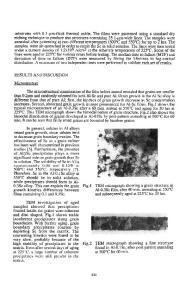Void Intergranual Motion Under the Action of Electromigration Forces in Thin Film Interconnects with Bamboo Structure
- PDF / 137,209 Bytes
- 7 Pages / 612 x 792 pts (letter) Page_size
- 49 Downloads / 398 Views
Void Intergranual Motion Under the Action of Electromigration Forces in Thin Film Interconnects with Bamboo Structure Ersin Emre Orena) and Tarik Omer Ogurtanib) Department of Metallurgical and Materials Engineering Middle East Technical University, 06531, Ankara, Turkey ABSTRACT The rigorous formulation of the internal entropy production, and the generalized forces and conjugate fluxes associated with the virtual displacement of a triple junction are presented in multi-component systems. Extensive computer simulations are performed on the void configurational evolution during the intergranual motion; under the actions of capillary and electromigration forces in thin film metallic interconnects with bamboo structure having various grain textures. The texture studies in this work show clearly that there are two different and very distinct modes, namely: the grain boundary carving or tearing mode, and the interconnect edge cutting mode by the oblique slit formation (about 450) on the wind-side of the grain boundary. INTRODUCTION Mullins [1] made the first study that was related to such kind of a triple junction. He investigated the grooving of a grain boundary without having the grain boundary diffusion by considering the triple junction to have the equilibrium capillarity configuration satisfying the Young relationship. Chuang and Rice [2], Pharr and Nix [3] and others [4-6] studied a similar problem, namely the creep cavity growth on grain boundary. They consider two coupled processes, namely the surface diffusion taking place on the interface separating the bulk phase from the cavity, and the grain boundary diffusion driven by the gradient of the normal stress acting in the boundary. The boundary conditions at the triple junction are assumed to be the continuity of the chemical potential, the equilibrium capillarity configuration for geometry, and the conservation of mass. These first two boundary conditions, as admitted by many investigators working in this field, are mutually incompatible at the triple junction even though they are widely used in their formulations relying on the validity of Herring’s relationship between chemical potential and the curvature, which is itself questionable at that geometric singularity. THEORY In this section the singular point associated with a triple junction is treated by using an ensemble of micro-discrete (straight) interfacial elements to represent the void surface layer as a convenient mathematical tool as proposed by Ogurtani [7]. Displacement velocities of the triple junction, longitudinal and transverse, are deduced as a by-product of the formulation of internal a) b)
Electronic mail: [email protected] Electronic mail: [email protected]
L5.5.1
Figure 1. Triple Junction Structure. entropy productions associated with the virtual displacements of the junction without making any assumption other than the fundamental postulates of linear irreversible thermodynamics [8]. As demonstrated inclusively in reference 7, one can rigorously write down the internal entropy produc
Data Loading...










